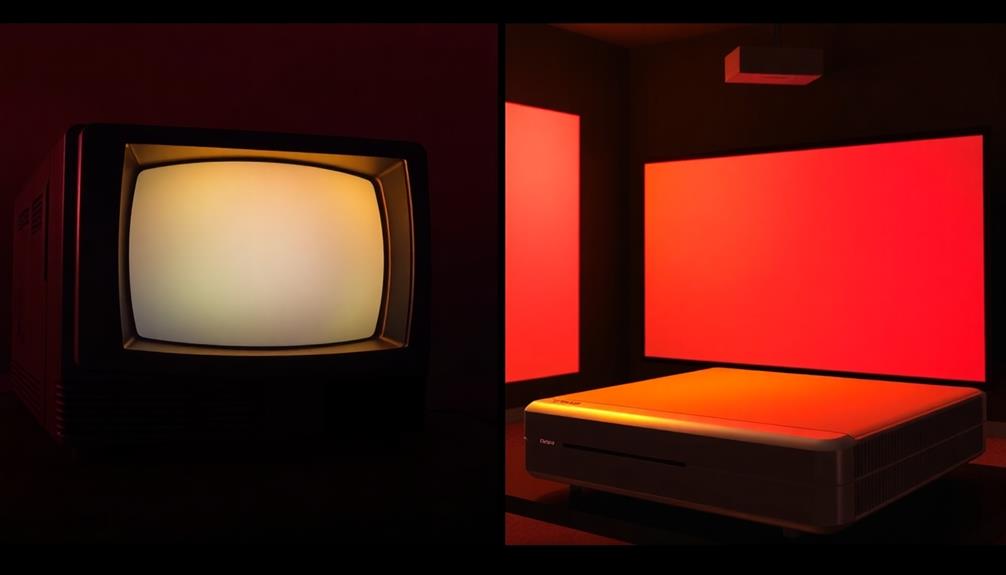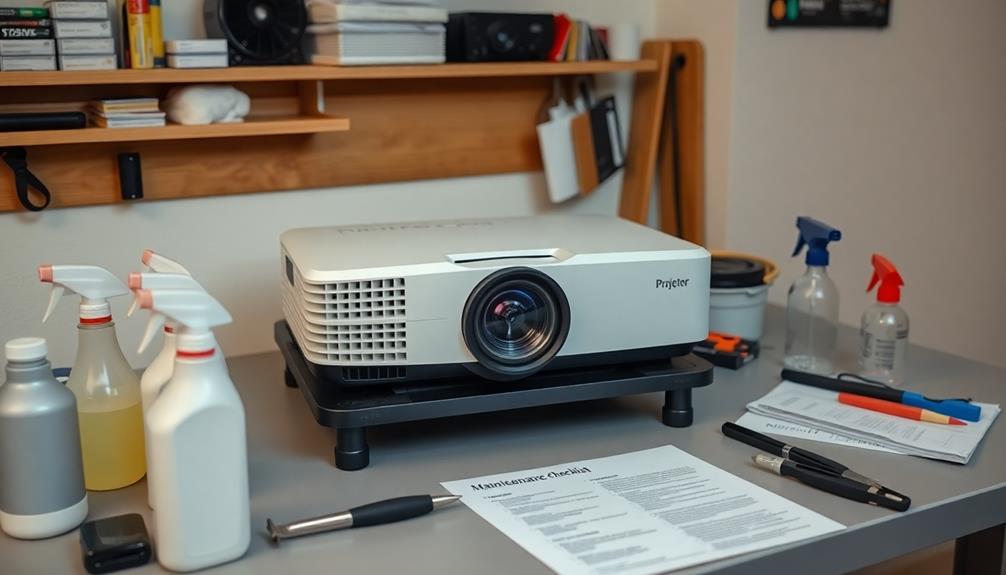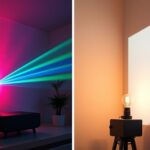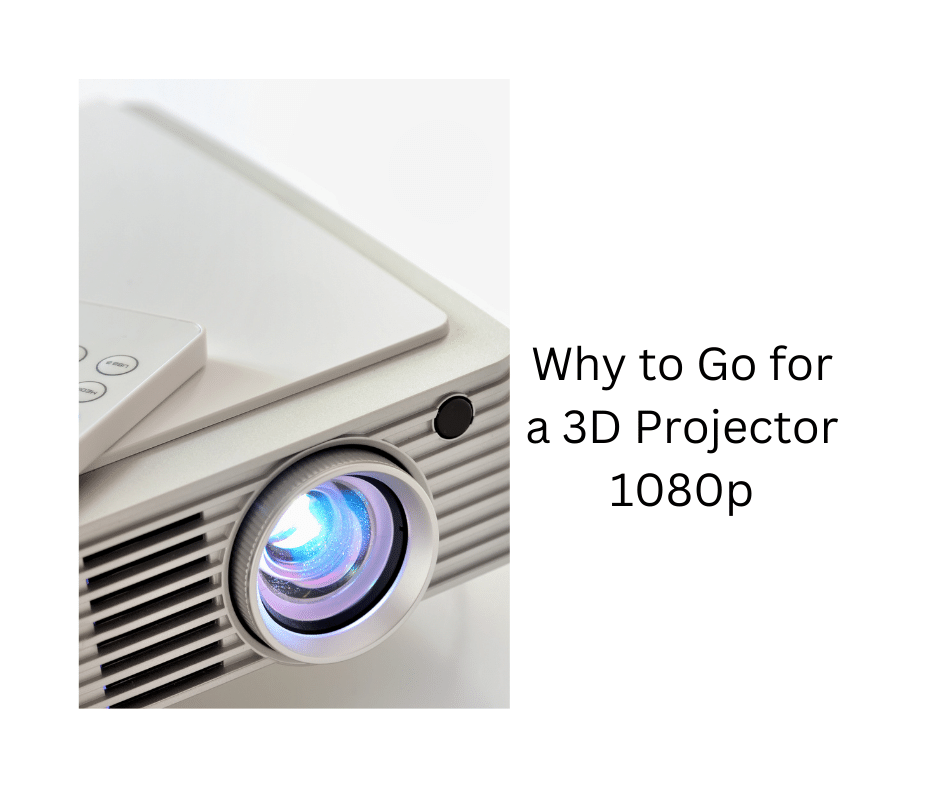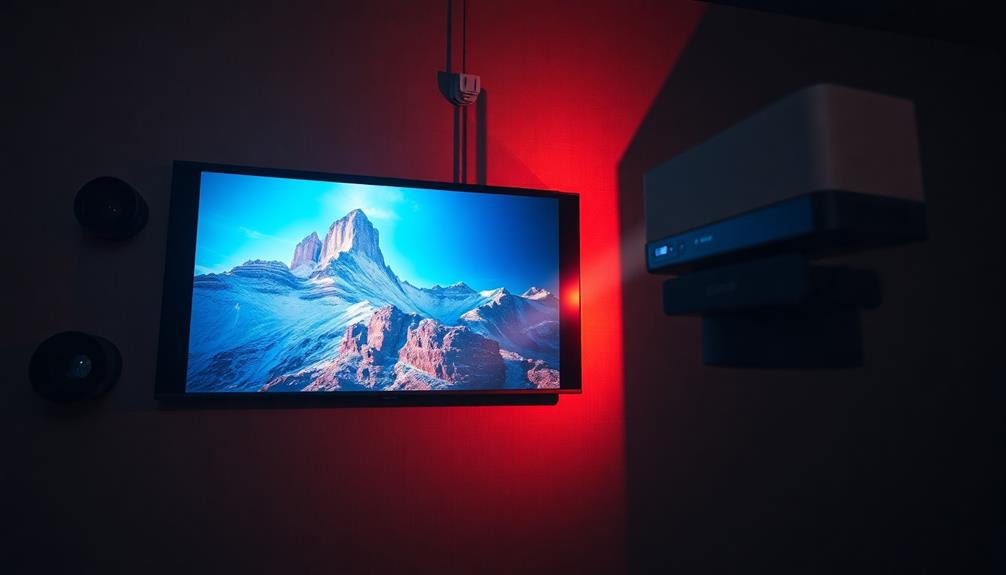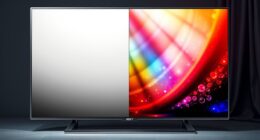Projector technology has come a long way since the days of bulky CRT systems. You've witnessed the shift from heavy, cathode ray tube projectors to lighter, more efficient LCD options in the 90s. Then, DLP technology emerged, offering better color accuracy and contrast. Fast forward to now, and laser projectors dominate the market, boasting bright images and long lifespans that exceed 20,000 hours. They offer users immediate access to vibrant visuals without the hassle of warm-up times. As technology advances, you'll discover even more fascinating developments set to shape the future of projection.
Key Takeaways
- The evolution of projectors began with the Camera Obscura and progressed to the Magic Lantern in the 17th century.
- CRT projectors, known for their excellent black levels, were bulky and faced decline in favor of lighter, more efficient technologies like LCD and DLP.
- The introduction of LCD projectors in the 1990s improved image quality and portability, leading to widespread adoption.
- Laser projectors offer significant advantages, including longer lifespans, instant on/off capability, and consistent brightness throughout their operational life.
- The projector market is projected to grow significantly, with laser projectors expected to dominate due to their superior performance and efficiency.
Historical Overview of Projection Technology
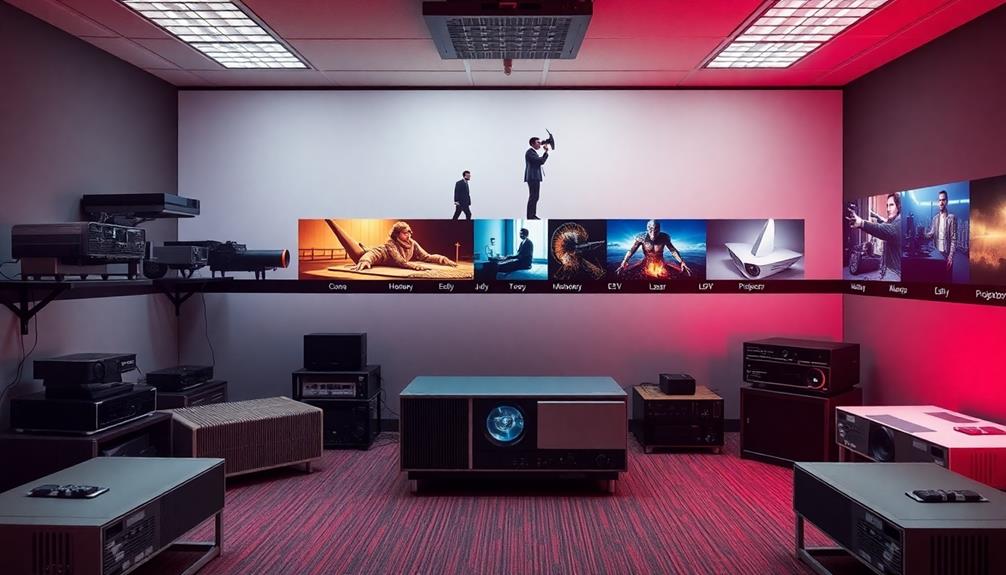
Projection technology has a rich history that stretches back to ancient times. You can trace its roots to the Camera Obscura, a principle first described in the 4th century BC by philosopher Mozi, showcasing how images could be projected through an aperture.
Fast forward to the 17th century, and you'd see the emergence of the Magic Lantern, a significant advancement that used glass slides to display images. This invention served as a precursor to modern projectors, paving the way for innovations like high refresh rates and low input lag essential for gaming enthusiasts top projectors for gaming.
In 1879, Eadweard Muybridge took a giant leap forward with the creation of the Zoopraxiscope, the first movie projector. This was vital in laying the groundwork for motion picture technology and public film screenings.
The late 20th century marked another evolution with the rise of digital projectors. Technologies like LCD and DLP transformed the projection landscape, drastically improving image quality.
Transition From CRT to LCD
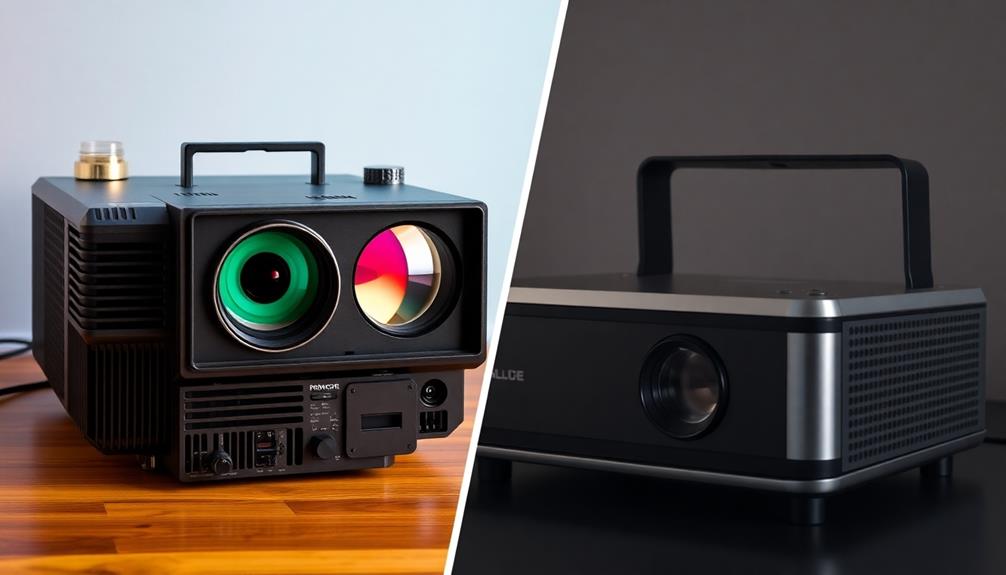
As you explore the change from CRT to LCD projectors, you'll notice how CRT limitations—like size and weight—led to their decline.
The advancements in LCD technology not only made projectors more portable but also greatly improved image quality.
Additionally, the emphasis on energy efficiency in modern devices reflects the broader trends in technology, similar to noise reduction technology in heating systems.
This shift opened the door for brighter, more vibrant visuals that transformed both educational and corporate settings.
CRT Limitations and Decline
Many users found Cathode Ray Tube (CRT) projectors challenging due to their bulk and weight, which demanded dedicated installation spaces. While CRT technology was renowned for its excellent black levels and high resolution, these advantages weren't enough to offset the increasing complexity and inefficiency of the systems.
Each projector relied on separate cathode ray tubes for red, green, and blue colors, making them cumbersome and less user-friendly. Additionally, the high power consumption of CRT projectors contributed to their declining popularity, as consumers began to prioritize energy-efficient options and financial health in their purchasing decisions.
As the late 1990s approached, the decline of CRT projectors became evident. The market began shifting toward more compact and efficient alternatives. The introduction of LCD projectors, starting with Epson's VPJ-700 in 1989, marked a significant turning point.
These projectors utilized three passthrough LCD panels, resulting in lighter designs that were easier to install and use. The change to LCD technology not only made projection more accessible but also allowed for brighter, more vivid images.
Major manufacturers like Sony and Sanyo recognized this shift and invested heavily in developing LCD projectors. By the late 1990s, digital video projectors, including LCD and DLP technologies, began to dominate the market, leading to the obsolescence of CRT projectors in most commercial applications.
Advancements in LCD Technology
Embracing advancements in LCD technology transformed the projection landscape, marking a clear departure from the limitations of CRT systems.
The introduction of the first modern LCD projector by Seiko-Epson in 1986 set the stage for this shift, boasting a resolution of 320 x 220 pixels and a brightness output of 70 lumens.
With LCD projectors, you gain several advantages:
- Portability: These projectors are considerably lighter and easier to transport than bulky CRT systems.
- Image Quality: The development of active-matrix LCD technology enhances image clarity and responsiveness.
- Brightness: Thanks to 3LCD technology, color accuracy and brightness have improved dramatically.
- Versatility: LCDs adapted well, evolving from overhead projectors to light-valve projectors, showcasing their flexibility.
Emergence of DLP Technology
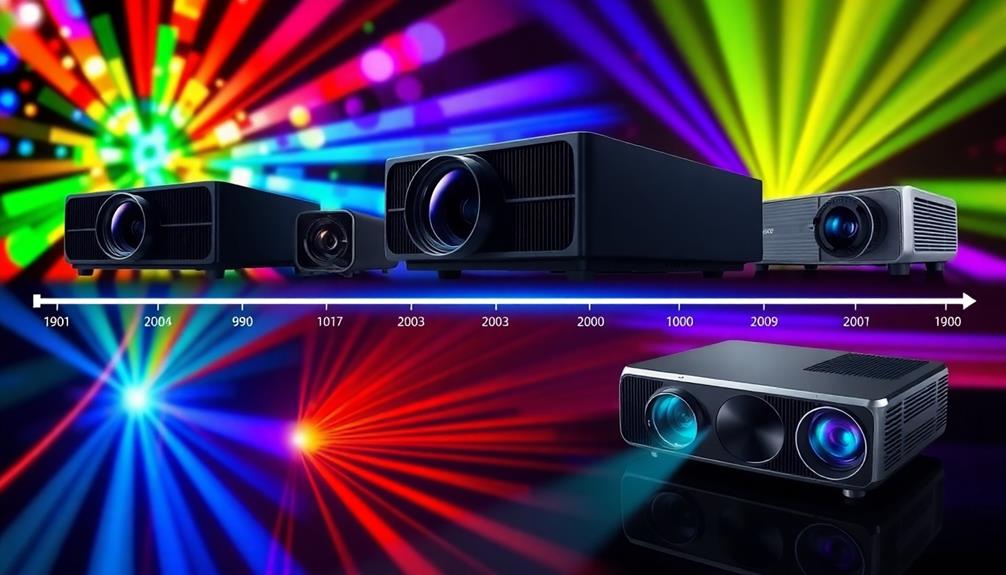
Digital Light Processing (DLP) technology revolutionized the projection landscape with its introduction by Texas Instruments in 1987. Utilizing microelectromechanical systems (MEMS), DLP technology employs thousands of tiny mirrors to modulate light, resulting in high-quality images that captivated both consumers and professionals.
By 1996, the first commercial DLP projector hit the market, marking a noteworthy milestone in portable projectors. These projectors quickly gained popularity due to their high contrast ratios and excellent color accuracy, making them ideal for various applications, including home theaters and corporate presentations.
By the late 1990s, DLP projectors accounted for around 50% of microdisplay-based projection system sales, showcasing their strong market presence.
As DLP technology evolved, advancements like time-division binary multiplexing and three-DMD configurations greatly improved gray-scale production and overall image quality. This relentless pursuit of excellence has cemented DLP technology's status as a preferred choice among users seeking reliable and high-performance projectors.
Whether you're watching a movie or delivering a business presentation, DLP projectors guarantee that your visuals stand out with clarity and vibrancy.
Advancements in Laser Projection

In recent years, laser projectors have transformed the way you experience visuals, offering enhanced color accuracy and a lifespan that exceeds 20,000 hours.
You'll appreciate the instant on/off capability, which eliminates annoying warm-up times.
These advancements not only improve convenience but also elevate the quality of your presentations and home entertainment.
Enhanced Color Accuracy
Laser projectors have revolutionized the way we experience color in visual displays, greatly enhancing color accuracy for various applications. By utilizing a wider color gamut than traditional UHP lamps, these projectors deliver vibrant and true-to-life color reproduction.
You can expect improvements in several key areas:
- Brighter images: Laser projectors achieve luminance output values over 10 times that of conventional lamps.
- Better color fidelity: Advanced modulation techniques help in precise color mixing, eliminating issues like color fringing.
- Dynamic light control: The integration of laser technology allows for precise adjustments in light intensity and color balance.
- Consistent color saturation: Research indicates that laser projectors maintain higher levels of color saturation and consistency over time, minimizing color shifts.
With laser projectors, you'll notice improved performance even in well-lit environments.
Their ability to maintain enhanced color accuracy across various projection systems means that you can enjoy richer visuals without compromising on quality.
Whether you're watching movies or presenting, laser projectors provide an unparalleled viewing experience that brings your content to life.
Longer Lifespan Benefits
How much longer can you enjoy your projector without worrying about replacements? With laser projectors, you can extend your viewing experience considerably, as they typically boast a lifespan exceeding 20,000 hours.
In contrast, traditional lamp-based projectors require lamp replacements every 2,000 to 5,000 hours. This longer lifespan means you'll face reduced maintenance costs and a lower total cost of ownership, letting you save money over time.
One of the standout benefits of laser projectors is their ability to maintain consistent brightness throughout their lifespan. Unlike traditional projectors, which often suffer from brightness degradation, laser projectors guarantee a reliable performance that keeps your images sharp and vivid.
Additionally, the energy efficiency of laser diodes contributes to their longevity, further reducing operational costs compared to conventional lamp technologies.
As more people recognize these advantages, the popularity of laser projectors continues to grow in various settings, from home theaters to corporate environments.
Instant On/Off Capability
One of the most impressive advancements in projector technology is the instant on/off capability of laser projectors. This feature eliminates the frustrating warm-up time associated with traditional lamps, which can take several minutes to reach full brightness.
With laser projectors, you'll enjoy immediate access to high brightness and vibrant color performance, greatly enhancing your user experience.
Here are some key benefits of the instant on/off capability:
- Quick Setup: Ideal for corporate presentations and educational settings, laser projectors are ready to go when you are.
- Reduced Thermal Stress: This feature minimizes thermal stress on components, contributing to the longevity of the projector, often exceeding 20,000 hours.
- Lower Operational Costs: With no warm-up needed, you'll save on energy during idle periods, leading to cost savings over time.
- Enhanced Efficiency: You can make the most of your time during events and presentations without delays.
The instant on/off capability not only streamlines your setup but also allows you to focus on delivering your message, making laser projectors a smart choice for anyone seeking reliability and performance.
Benefits of Modern Laser Projectors
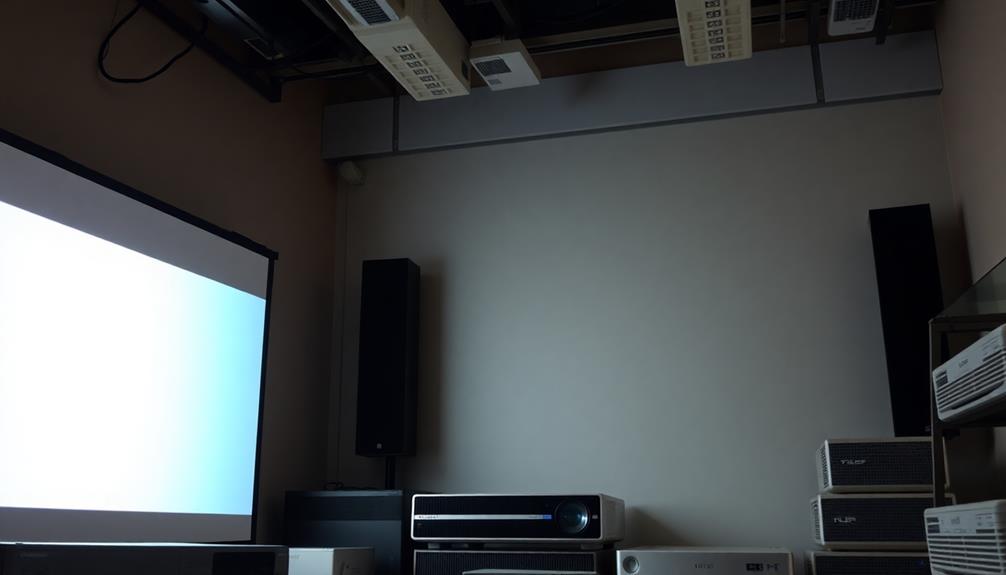
Modern laser projectors bring a host of benefits that elevate your viewing experience, whether for business presentations or home entertainment. One of the standout features is their exceptional color performance. With wider color gamuts, these projectors provide richer color reproduction, ensuring that every detail pops.
You'll appreciate the high resolution that brings your visuals to life.
Another significant advantage is their instant on/off capabilities, which eliminate the frustrating warm-up time associated with traditional projectors. This is especially handy when you need to start a presentation on the fly.
You'll also benefit from lower maintenance costs, as laser projectors typically last over 20,000 hours, far surpassing lamp-based models that require frequent replacements.
In terms of total cost of ownership, laser projectors are a smart investment. Their energy efficiency not only reduces operational costs but also makes them suitable for diverse applications, from home theaters to large venues.
Market Trends and Growth
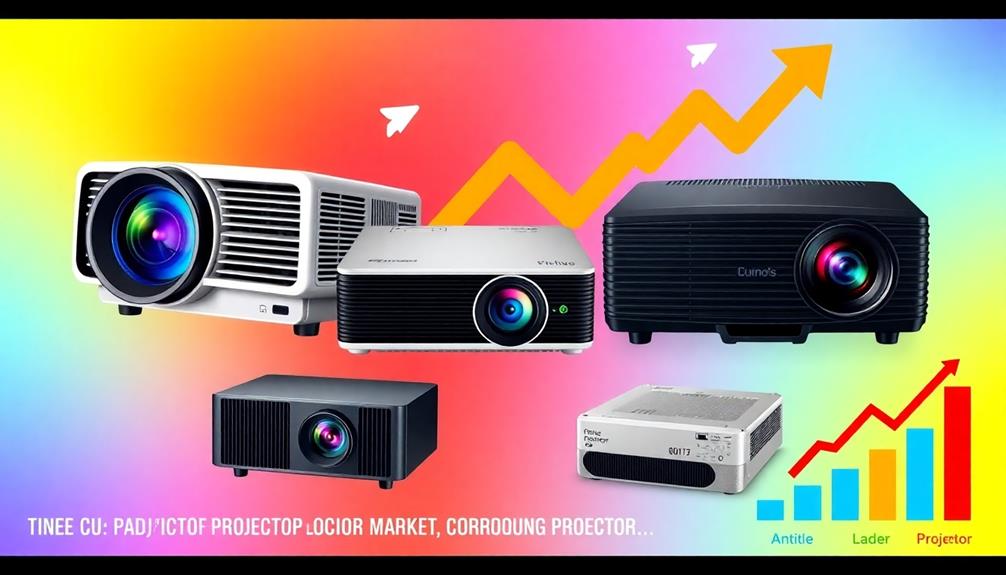
The projector market is experiencing a dynamic shift, with projections estimating its value to reach $10 billion by 2025. This growth is driven by a rising demand for home cinema setups and advancements in educational applications.
Laser projectors are set to dominate, boasting a compound annual growth rate (CAGR) of over 20% due to their superior brightness, longevity, and enhanced resolution and HDR capabilities compared to traditional light sources.
Key trends contributing to market growth include:
- Increased adoption of digital projectors for both commercial and residential use.
- Continued use of advanced projection technology in corporate presentations and events.
- The rise of portable projectors, making projection technology more accessible and convenient.
- A growing interest in high-quality visuals and immersive experiences in home entertainment.
As you explore these trends, you'll see how they reflect a broader shift toward innovative projection solutions.
Whether you're looking to upgrade your home cinema or improve your presentations, understanding these market dynamics can help you make informed decisions.
The future of projection technology looks bright with exciting developments on the horizon.
Innovations in Projection Applications
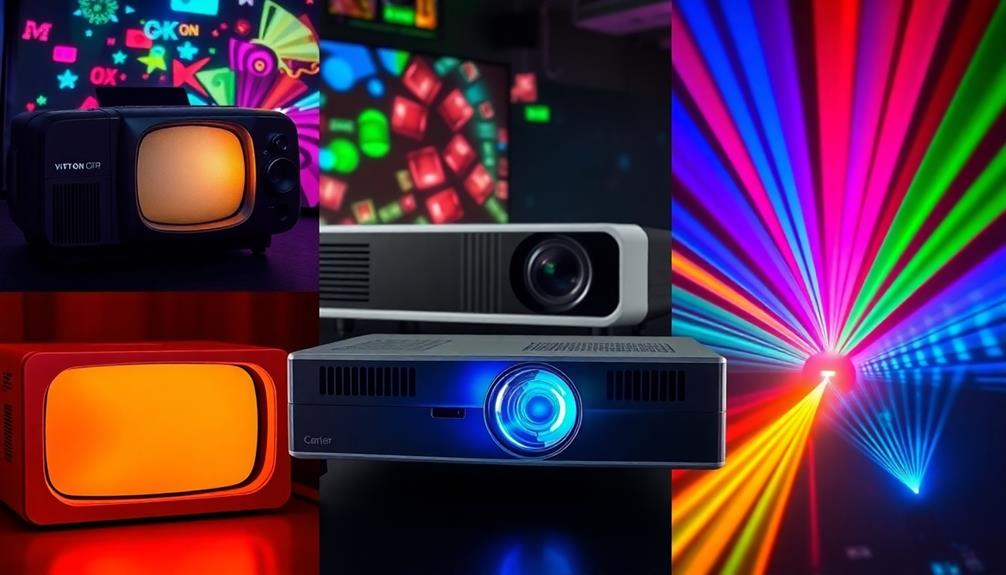
As the projector market continues to grow, innovations in projection applications are reshaping how you experience visual content across various sectors.
The shift from traditional CRT projectors to digital technologies like LCD and DLP in the late 1990s greatly improved image quality and portability. Nowadays, you can easily find high-quality laser projectors that offer advantages over lamp-based systems, including longer lifespans and enhanced color accuracy, making them perfect for home theaters and corporate presentations.
The rise of pico projectors highlights the trend toward compact, low-power solutions that fit seamlessly into your mobile device lifestyle. These tiny projectors allow you to share presentations and entertainment anytime, anywhere.
Additionally, innovations in interactive projection technologies have transformed educational and training environments, creating immersive learning experiences that foster engagement through dynamic content display and user interaction.
Whether you're in a classroom, boardroom, or living room, today's projection applications harness light in remarkable ways, ensuring that you don't just view content—you experience it like never before.
Future Directions in Projection Tech
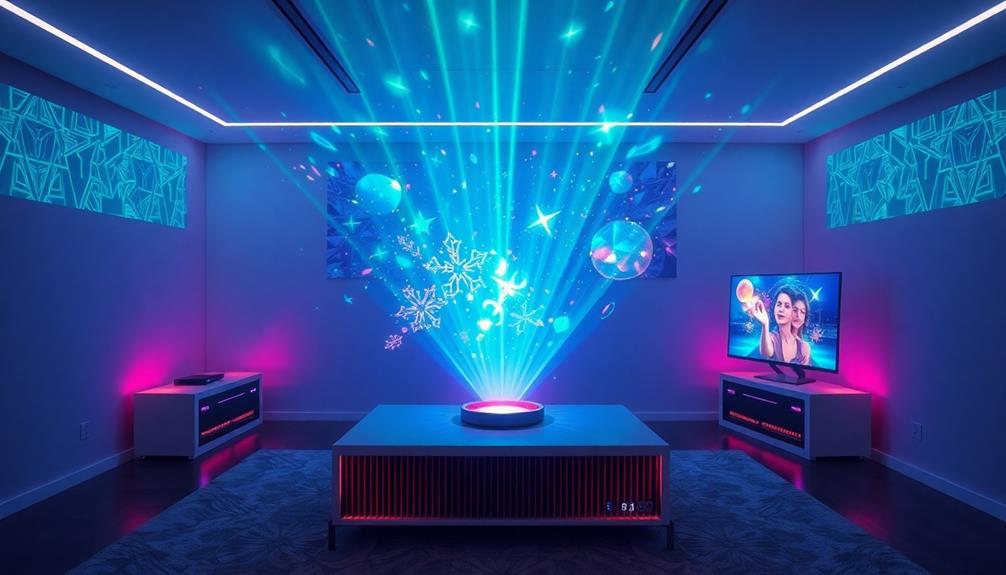
Exciting advancements in projection technology are on the horizon, promising to redefine how you interact with visual content. As we look to the future, several key trends are shaping the landscape of projection technology:
- MicroLED and OLED: Expect next-generation projectors with high efficiency and improved color accuracy.
- Artificial Intelligence: This will enhance image processing, potentially revolutionizing content creation and display.
- Portable Solutions: The market's trend towards compact projectors means you'll have high-quality projection options that are easily accessible for on-the-go use.
- Eco-Friendly Innovations: A focus on sustainability in projector manufacturing will lead to more energy-efficient systems using eco-friendly materials.
These innovations not only enhance visual experiences but also pave the way for interactive projection technologies, increasing user engagement in education, business, and art installations.
As these advancements unfold, you'll benefit from greater accessibility, better performance, and a more sustainable approach to projection technology.
Get ready for a future where projection systems are versatile, efficient, and environmentally conscious, transforming how you connect with and experience visual content.
Challenges Facing Projection Technology
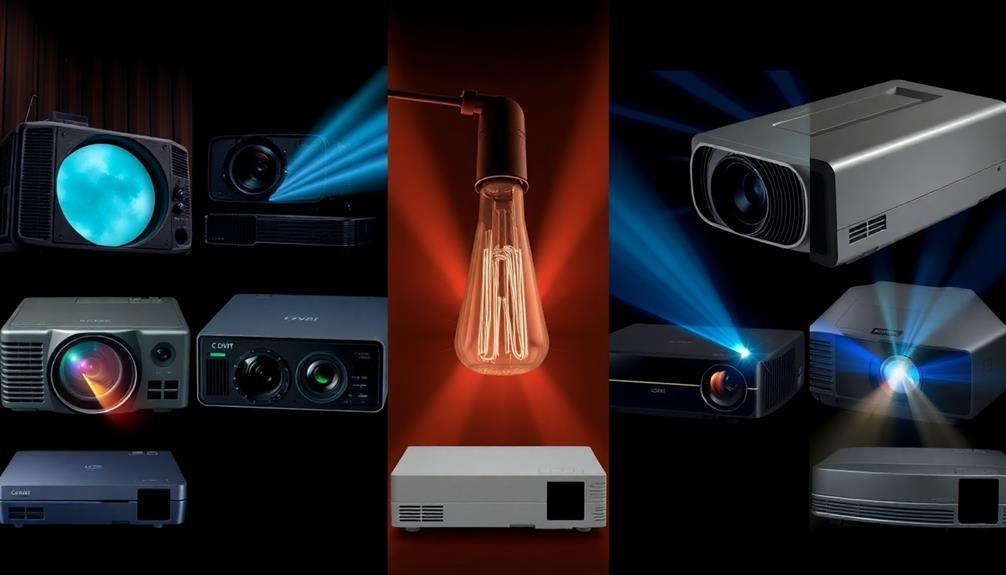
Maneuvering the landscape of projection technology comes with its own set of challenges. The shift from traditional systems, like CRT and lamp-based projectors, to modern laser projectors involves high manufacturing costs and the necessity for specialized components.
While laser projectors deliver impressive brightness and longevity, they face hurdles concerning safety standards and the intricate nature of laser modulation technology.
Moreover, competition from alternative display technologies, such as OLED and microLED, threatens to overshadow traditional projection systems, complicating market dynamics.
You're likely aware that ongoing research is essential to enhance the efficiency and scalability of liquid crystal on silicon (LCoS) technologies. These advancements are significant for meeting demands for higher resolutions and faster modulation speeds.
Lastly, the environmental impact of projector manufacturing can't be ignored. As the industry works to minimize energy consumption and use eco-friendly materials, addressing sustainability remains a pressing challenge.
Balancing innovation with these challenges is essential for the future of projection technology, ensuring it adapts to ever-evolving consumer needs while also being responsible to our planet.
Frequently Asked Questions
What Is the Evolution of the Projector?
The evolution of projectors involves advancements in technology, moving from bulky CRT models to lighter LCD and DLP options. Now, you're seeing laser projectors take the lead with superior brightness, longevity, and color accuracy.
What Is the History of CRT Projectors?
You'll find that CRT projectors emerged in the mid-20th century, featuring three cathode ray tubes for color. Despite their decline in the late 1990s, they excelled in specialized applications with exceptional image quality.
What Is the Laser Technology in Projectors?
Imagine you're presenting a project using a laser projector. These devices use laser diodes for bright images, wider color gamuts, and instant on/off capabilities, making them more efficient and cost-effective than traditional lamp projectors.
What Is the Difference Between DLP and Laser Projector?
DLP projectors use micro mirrors for image creation, offering high contrast and lower upfront costs. Laser projectors provide broader color accuracy and longer lifespan, along with instant on/off functionality, making them ideal for consistent performance.
Conclusion
As you stand before a vibrant canvas of light, it's clear that projector technology has transformed from the flickering shadows of CRT to the brilliant beams of laser innovation. This evolution symbolizes a journey through time, where each advancement paints a new picture of possibility. With modern projectors illuminating our world, you're invited to embrace the future—where creativity knows no bounds and every presentation becomes a masterpiece. The stage is set; let the show begin!
Hi, I’m Dominique. I love movies and want everyone to have the best home cinema experience possible. That’s why I started 1home Theatre Projector. We help people build their home cinema system using the latest technology and news on laser tv and all-around home entertainment.
We’re a small team of movie buffs (and experts) who are passionate about giving our readers the best advice and information possible. So whether you’re just starting out or you’re looking to upgrade your home cinema system, we’ve got you covered!
